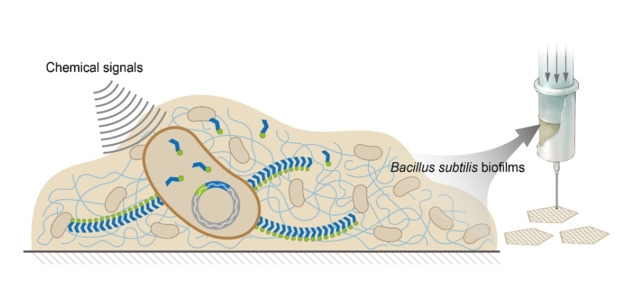In a paper entitled “Programmable and printable Bacillus subtilis biofilms as engineered living materials,” a team of researchers discusses how they used 3D printing to produce custom nanoscale biomaterials from the natural secretion of amyloid fibers from the bacteria Bacillus subtilis. The bacteria generate biofilms by secreting amyloid fibers via a tightly controlled cluster of genes called the tapA-sipW-tasA operon. TapA nucleates the extracellular assembly of TasA proteins to create the amyloid nanofibers that give the biofilm its structural integrity. The researchers were able to genetically modify the TasA protein and introduce functional chemical groups onto the TasA fibers excreted by the bacteria. This means that the bacterial films could be designed to act as functional living materials.
The researchers were able to engineer the bacteria to secrete fibers containing enzymatic functional groups into harmless products. They also combined the biofilms produced with multiple bacterial strains, which allowed them to perform a two-step degradation of the pesticide paraoxan. This shows the potential for producing efficient, eco-friendly materials.
In addition to showing the functional capabilities of the biofilms, the researchers also studied their processability as materials. Because of the viscoelastic properties of the biofilms, they are well-suited to 3D printing. Modifying the functional groups on the secreted enzymes did not hinder the processability of the biofilms, instead enabling the researchers to tune their viscoelastic properties for 3D printing applications.
“In a series of increasingly complex proof-of-concept demonstrations, we deployed these engineered biofilms in fluorescence detection, conjugation chemistry, single-substrate bioremediation, and multireaction bioremediation cascades incorporating NPs,” the researchers state.“We also exploited the intrinsic viscoelastic properties of our engineered biofilms and fabricated well-defined ‘living shapes’, trapping these materials into hydrogels and microgels using 3D printing and microencapsulation techniques.”
The living materials were shown to be able to self-regenerate after printing, sustaining their original printing shape as well as their viscoelastic and functional properties. The bacteria were able to incorporate onto their fibers without affecting the biofilm growth or cell viability. The cells remained viable for five weeks without supplemental nutrition.
“As this new type of living functional material offers previously unattainable material performance properties relevant to manufacturing, our study opens the door for the development of many conceivable new classes of complex multifunctional materials and dynamic and regenerative nanotechnologies,” the researchers conclude.
Authors of the paper include Jiaofang Huang, Suying Liu, Chen Zhang, Xinyu Wang, Jiahua Pu, Fang Ba, Shuai Xue, Haifeng Ye, Tianxin Zhao, Ke Li, Yanyi Wang, Jicong Zhang, Lihua Wang, Chunhai Fan, Timothy K. Lu and Chao Zhong.
Discuss this and other 3D printing topics at 3DPrintBoard.com or share your thoughts below.
Subscribe to Our Email Newsletter
Stay up-to-date on all the latest news from the 3D printing industry and receive information and offers from third party vendors.
You May Also Like
3D Printing Financials: Fathom Struggles in Financial Quicksand During Critical Transition
Facing a year of key transitions and financial pressures, Fathom (Nasdaq: FTHM) has filed its annual report for 2023 with the U.S. Securities and Exchange Commission (SEC). The document outlines...
Latest Earnings Overview for Australian 3D Printing Firms Titomic and AML3D
Australian 3D printing manufacturing firms Titomic (ASX: TTT) and AML3D (ASX: AL3) reported their financial results for the period from July to December 2023, marking the first half of their...
3D Printing Webinar and Event Roundup: April 7, 2024
Webinars and events in the 3D printing industry are picking back up this week! Sea-Air-Space is coming to Maryland, and SAE International is sponsoring a 3D Systems webinar about 3D...
3D Printing Financials: Unpacking Farsoon and BLT’s 2023 Performance
In the Chinese 3D printing industry, two companies, Farsoon (SHA: 688433) and Bright Laser Technologies, or BLT (SHA: 688333), have recently unveiled their full-year earnings for 2023. Farsoon reported increases...


































